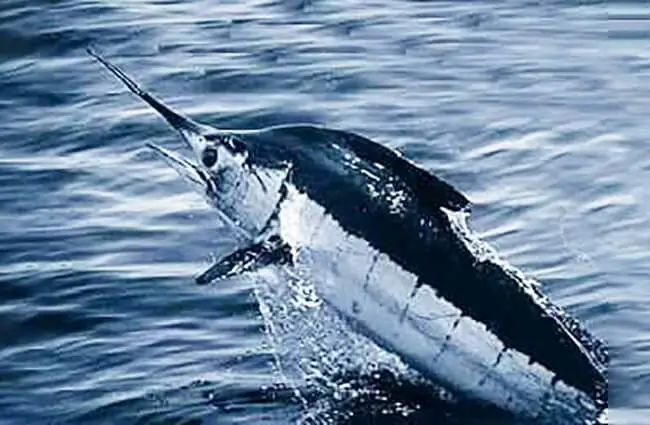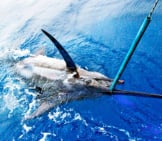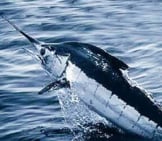The Blue Marlin is a species of fish in the Istiophoridae family. Other members of the family include the sailfish, black marlin, white marlin, spearfish, and other marlin species.
Researchers used to classify this fish into two different species. However, DNA has suggested that populations in Atlantic and Indo-Pacific are the same species. Read on to learn about the Blue Marlin.
Description of the Blue Marlin
This fish shares the same general characteristics as the rest of its family. It has a long, pointed bill that it uses to hunt its prey. It also has a dorsal fin which it can stand erect on its back, though the fin on this species is not quite as impressive as the related sailfish.
These fish can reach incredible sizes. The largest recorded individual measured over 16 ft. long and weighed just over 1,800 lbs. However, most adults average between 7 and 10 ft. long and weigh between 250 – 400 lbs.
Interesting Facts About the Blue Marlin
This fish species has a number of interesting traits and adaptations. Learn more about what makes them unique, below.
- National Fish – This species has an easy to recognize shape. In fact, these creatures are so renowned that the Commonwealth of the Bahamas recognizes it as their national fish!
- Sexual Dimorphism – These fish display sexual dimorphism, where males and females look noticeably different. In this species, the females can reach up to four times the size of the males.
- Makaira – The genus name of this species, Makaira, comes from the Greek “machaira,” which means short sword. This choice of genus name refers to the fish’s pointed, sword-like bill.
- Need for Speed – Though their pointed dorsal fin gives them part of their characteristic look, they don’t always keep it aloft. In fact, while swimming, they fold most of their fins down to reduce drag and swim even faster.
Habitat of the Blue Marlin
Like other members of Istiophoridae, these fish have pelagic lifestyles. They live in open ocean and do not consistently associate with the coastlines or the seafloor. Additionally, they inhabit the epipelagic zone, or the region closer to the surface of the ocean where light penetrates.
Distribution of the Blue Marlin
You can find this species in temperate, subtropical, and tropical waters globally. One population lives in the Atlantic Ocean. The Atlantic population does not mix with the Indo-Pacific population that lives in the Indian Ocean, Pacific Ocean, and the Indo-Pacific region.
Diet of the Blue Marlin
This species has carnivorous feeding habits. More specifically, researchers classify this (and most marlins) as piscivorous, as fish make up the bulk of their diet. They feed on a wide variety of different fish and squid.
Like other members of the Istiophoridae family, this species hunts using its pointed bill. It does not spear prey. Instead, it dashes into a school of fish and quickly swings its bill back and forth. After it has killed or stunned the prey, it easily eats them.
Blue Marlin and Human Interaction
Humans interact with this species in several ways. People heavily target this fish in sport or recreational fishing for its impressive size and athletic ability. Additionally, commercial fisheries harvest this species intentionally and accidentally as bycatch.
This activity has significantly reduced global populations of this fish. For this reason, the IUCN lists the species as Vulnerable and declining.
Domestication
Humans have not domesticated this species in any way.
Does the Blue Marlin Make a Good Pet
No, you wouldn’t want to keep this fish as a pet. It reaches sizes much too large to comfortably house in a home aquarium.
Blue Marlin Care
People do not keep these fish in aquariums. With their pelagic lifestyle, they swim long distances in open ocean. Because they can swim so quickly, running into the sides of a tank, even an incredibly large one, could be dangerous or lethal to the fish.
Behavior of the Blue Marlin
Unlike some other members of its family, this species lives a primarily solitary life. It swims alone and only interacts with other members of its species during the breeding season. Sometimes several individuals will target a single food source, but this occurs incidentally.
Reproduction of the Blue Marlin
These fish reproduce at different times in different regions of the world. They breed via spawning, where the females release their eggs into the water and the males fertilize them outside of the body. A single female can produce several million eggs. The young attain sexual maturity when they reach between two and four years of age.







![Red Angus Closeup of a beautiful Red Angus cowPhoto by: U.S. Department of Agriculture [pubic domain]https://creativecommons.org/licenses/by/2.0/](https://animals.net/wp-content/uploads/2020/03/Red-Angus-4-238x178.jpg)












![Red Angus Closeup of a beautiful Red Angus cowPhoto by: U.S. Department of Agriculture [pubic domain]https://creativecommons.org/licenses/by/2.0/](https://animals.net/wp-content/uploads/2020/03/Red-Angus-4-100x75.jpg)

